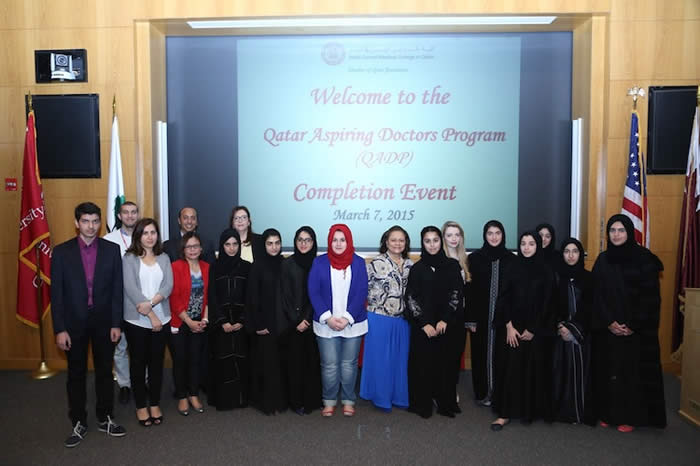Student outreach program doubles in size in just one year
October, 2015

The closing event from the first QADP that finished in March. The scheme has since doubled in size and in September 37 potential students were taken on - 35 of whom are Qatari.
An innovative program that has seen faculty and staff work together to support student outreach has seen 37 potential doctors join its ranks.
The Qatar Aspiring Doctors Program (QADP) was launched by the Office of Student Recruitment and Outreach at WCM-Q last year as a pilot program, its aim being to academically support potential students and prepare them for life as WCMC-Q undergraduates.
In all, 18 students were selected to take part in QADP, 12 of whom were offered admissions in WCM-Q, and seven are now current WCM-Q students.
So successful was the scheme that it has been expanded this year to take on 37 potential students – 35 of whom are Qatari. These 37 will now complete online modules and laboratory-based work over a six-month period. Modules include: physical sciences taught by Dr. James Roach, biology taught by Dr. Ghizlane Bendriss, ESL taught by Dr. Rachid Bendriss, and research skills taught by Ms. Reya Saliba. They will also receive advice on how to tailor their application to WCM-Q to be in with the most chance of success.
An enhanced version of the QADP this year includes a standardized testing module to help prepare the students early enough to meet college requirements.
Dr. Rachid Bendriss, assistant dean for student recruitment, outreach and foundation programs at WCM-Q, said last year’s QADP had helped the selected students reach the academic level required of them to join WCM-Q and he had high hopes for this year’s cohort. He also said the program was a shining example of departmental collaboration.
Dr. Bendriss said: “We have had faculty members, IT and the Office of Student Recruitment and Outreach all working together to create an interesting, academically rigorous, online curriculum that the students can complete remotely in their own time. In addition, faculty deliver certain classes and modules face-to-face at WCM-Q.
“The QADP program has been very successful; out of last year’s program, 60 per cent are now at WCM-Q and the figure would have been higher, but some of the students were too young to apply.”
The QADP students are selected by WCM-Q from those who participate in the summer and winter enrichment programs. The participants are between the ages of 15 ad 17, hence why some of those who complete the QADP may be unable to apply to WCMC-Q immediately.
Dr. Ghizlane Bendriss, a teaching specialist in biological sciences, said the participants are very motivated and the biggest challenge for teachers is to engage with them without having regular face-to-face contact.
She said: “As students are in their 11th or 12th grade during the academic year, the main challenge was to establish a smooth communication and regular meetings with the students, without overwhelming them. Thanks to the coordinated work with our IT department, students were allowed to have access to the Canvas learning management system, which allowed us to establish a secure space to communicate with the students all material needed and to arrange our meetings on site.
“The Office of Student Recruitment and Outreach conscientiously managed the program and organized our meetings to avoid bringing students several times in a small period of time and by dividing courses into short modules and adding deadlines, we managed to keep the students engaged throughout the year. The lab activities were a great opportunity for the students to work in a biology laboratory using material that they may not have in their own schools, which increased students’ interest in this program.”
Sharon Hollinsworth, director of education computing for Information Technology Services, said the QADP was a chance for the college to make even greater use of its software for the benefit of potential students alongside existing undergraduates.
She said: “It was a great opportunity for us to utilize existing technology with our learning management system to engage prospective Qatari students in learning and developing skills to be successful candidates.
“One of the added benefits for them was that it actually assisted them with their high school course work as well.
“Young people embrace technology so easily, and because the program materials were within the learning management system, the course was self-driven, meaning they could learn at their own speed.”
Fatema Almarri is an example of how beneficial the QADP can be. A previous participant herself, she is now in the first year of the six-year medical program.
Fatema said: “We were taught the scientific basics and that helped me when starting off this semester. We had the physical sciences and biology and worked in labs, which also helped when starting this year. The program taught us different lab techniques and how to work with certain equipment. It made it that I was very comfortable in the lab when I joined the medical program, whereas others weren’t.
“We also undertook research on various topics. Mine was biomechanics and it was the first proper research I had done and I had to put a lot of thinking into it. The QADP really helped teach me how to approach a research project.”
The QADP runs from September to March. Upon completion, each student receives a certificate, but more importantly they will have gained valuable skills that will aid them in their application to WCM-Q.

